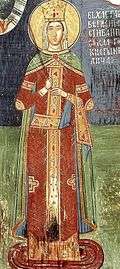Princess Milica of Serbia
| Milica of Serbia | |
|---|---|
|
Fresco from the Ljubostinje monastery (1402–1405) | |
| Born | 1335 |
| Died | November 11, 1405 |
| Burial | Ljubostinja |
| Spouse | Lazar of Serbia |
| Issue | Stefan Lazarević |
| House | Nemanjić dynasty |
| Father | Vratko Nemanjić |
| Religion | Serbian Orthodox |
Princess Milica Hrebeljanović née Nemanjić (Serbian: Милица Хребељановић · ca. 1335 – November 11, 1405) also known as Empress (Tsaritsa) Milica, was a royal consort of Serbia. Her husband was Serbian Prince Lazar and her children included despot Stefan Lazarević, and Jelena Lazarević, whose husband was Đurađ II Balšić. She is the author of "A Mother's Prayer" (Serbian: Молитва матере) and a famously moving poem of mourning for her husband, My Widowhood's Bridegroom (Serbian: Удовству мојему женик).
Biography
She was the daughter of Prince Vratko Nemanjić (known in Serb epic poetry as Jug Bogdan), who as a great-grandson of Vukan Nemanjić was part of a minor branch of the Nemanjić dynasty. Her husband was Prince Lazar Hrebeljanović. She was the fourth cousin once removed of Emperor Dušan of Serbia.
After the death of her husband at the Battle of Kosovo in 1389, Milica ruled Serbia until 1393 when her son, Stefan Lazarević Hrebeljanović, came of age to take the throne.[1] At that time, much wisdom and personal courage was needed to reign in a country which was nominally free but always under threat of invading forces, from the East and the West. It was difficult to maintain a national spirit without provoking neighbouring kingdoms or pashaluks to raid or plunder. Milica proved herself an able ruler of the country at a very trying time. Her personal tragedy (losing her husband and sending her daughter Mileva (Olivera Despina) to marry Bayezid I, who had ordered the execution of her husband Prince Lazar in 1389) did not interfere with her carrying out her duties. She founded the Ljubostinja monastery around 1390 and later took monastic vows at her monastery and became the nun Eugenia (Јевгенија, later abbess Euphrosine, Јефросина) around 1393.[2]
In 1397 she issued the "A Mother's Prayer" together with her sons at the Dečani monastery.[3] She commissioned the repairing of the bronze horos of Dečani.[2]
In later diplomatic negotiations with Sultan Bayezid I, Eugenia and Euphemia, the former Vasilissa of Serres, both travelled to the Sultan's court in 1398/99.[4]
In 1403, Eugenia went to the Sultan at Serres, arguing in favour of her son Stefan Lazarević in a complicated dispute that had emerged between her two sons and Branković.[2]
She was buried in Ljubostinja, her monastery. She was canonized by the Serbian Orthodox Church. Princess Milica was also a writer. She wrote several prayers and religious poems. It appears that her grief and loneliness were captured in her highly lyrical and poetic address to Prince Lazar (Hrebeljanović). Although conceived as a church hymn, it contains a personal note and lyrical tones unusual for solemn and somber church hymnody.
Family
With Prince Lazar she had the following sons:
- Dobrovoj, died after birth
- Despot Stefan,
- Vuk Lazarević
and following daughters:
- Jelena Lazarević, whose husband was Đurađ II Balšić and of Grand Duke of Hum Sandalj Hranić Kosača
- Mara Lazarević, whose husband was Vuk Branković
- Dragana, whose husband was Emperor Ivan Shishman of Bulgaria
- Teodora
- Olivera 'Despina', whose husband was Bayezid I.
See also
References
- ↑ Vujić, Joakim (2006), "The transformation of symbolic geography: Characteristics of the Serbian people", in Trencsényi, Balázs; Kopeček, Michal, Late enlightenment emergence of the modern 'national idea, Budapest New York: Central European University Press, p. 115, ISBN 9789637326523.
- 1 2 3 Gavrilović, Zaga (2006), "Women in Serbian politics, diplomacy and art at the beginning of Ottoman rule", in Jeffreys, Elizabeth M., Byzantine style, religion, and civilization: in honour of Sir Steven Runciman, New York: Cambridge University Press, pp. 75–78, ISBN 9780521834452.
- ↑ Popovich, Ljubica D. (1994). "Portraits of Knjeginja Milica". Serbian Studies. North American Society for Serbian Studies. 8 (1–2): 94–95. Pdf.
- ↑ Ćirković, Sima M.; Korać, Vojislav; Babić, Gordana (1986). Studenica Monastery. Belgrade: Jugoslovenska Revija. p. 144. OCLC 17159580.
Sources
- Miladin Stevanović (2005). Kneginja Milica Hrebeljanović. Knjiga-komerc.
| Wikimedia Commons has media related to Princess Milica of Serbia. |
